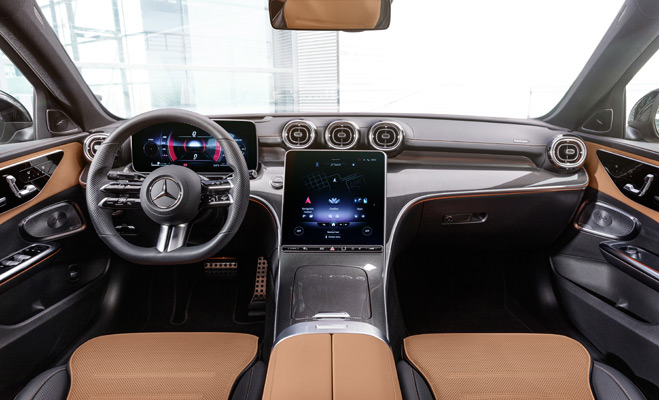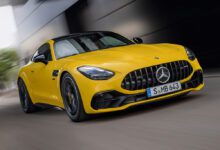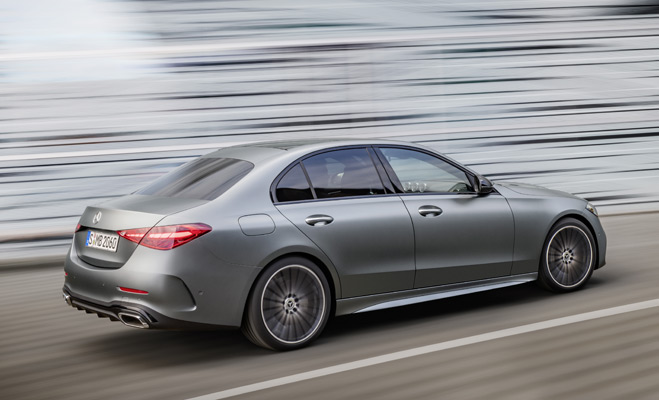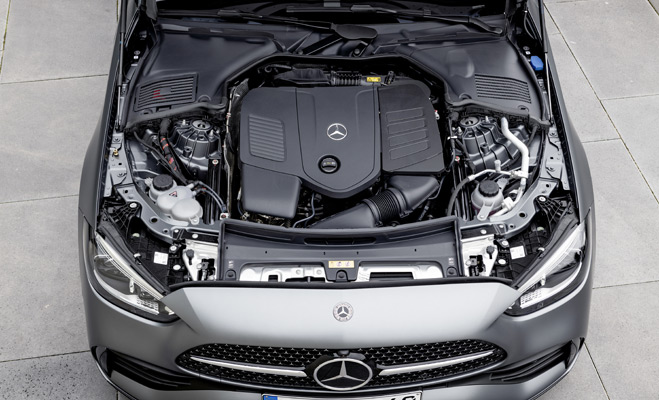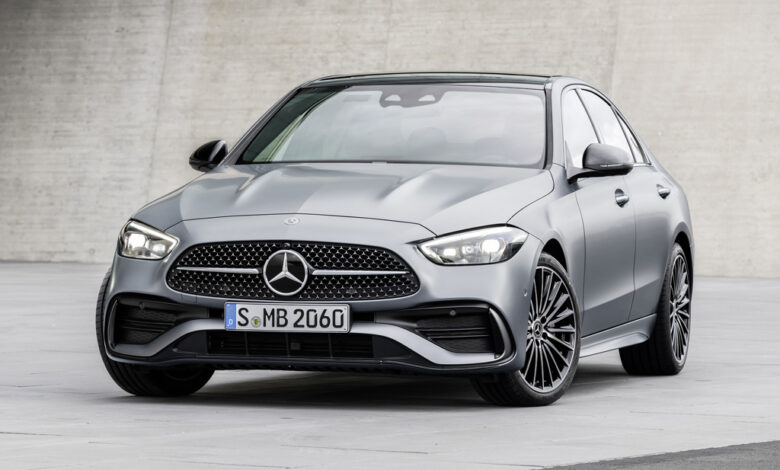
New C-Class: electrified powertrains and plug-in hybrids with a range of around 100 km.
Systematic electrification and intelligent downsizing mean that the latest C-Class sets new standards in efficiency. The model's engine range includes exclusively electrified 4-cylinder engines from the current Mercedes-Benz FAME modular engine family, which plays an important role in achieving flexibility within the international production network. Shortly after launch, plug-in hybrids with a range of around 100 km (WLTP) on electric power will be added to the range.
Both diesel and gasoline engines, other than turbocharging, use a second-generation system, the so-called mild hybrid starter integrated with a generator (ISG). The ISG uses a 48-volt on-board electrical system to provide features such as "sailing", extra torque "injection" on acceleration and energy recovery. The result: a significant reduction in fuel consumption. In addition, thanks to ISG, the units start very quickly and comfortably. As a result, the operation of the start/stop function is almost as imperceptible to the rider as the transition from coasting with the engine off to dynamic acceleration. In addition, intelligent cooperation with ISG ensures extremely smooth idling of the unit.
First diesel engine with integrated starter/generator
At the forefront of efficiency efforts is the new OM 654 M diesel engine with Integrated Starter Generation II (ISG) and 48-volt on-board electrical system. Energy recovery and drive-off "coasting" functions make the engine even more economical. In addition to electrification, which includes the use of an electric compressor in the air conditioning system, the list of the most important modifications includes:
- new crankshaft increasing stroke to 94.3 mm and displacement to 1992 cc (previously: 92.3 mm and 1950 cc)
- injection pressure increase to 2700 bar (previously: 2500 bar)
- Extremely fast response times and smooth power delivery thanks to the use of two liquid-cooled turbochargers, which now feature a variable geometry turbine.
- sodium-filled cooling channels in each steel piston; this helps dissipate temperature spikes in the combustion chamber
The diesel engine also takes a step forward in the field of exhaust gas treatment. In this case, the steps include:
- NOx catalytic converter in the engine to reduce nitrogen oxides.
- DPF (diesel particulate filter with a special coating that also reduces the amount of nitrogen oxides)
- SCR Catalytic Converter (Selective Catalytic Reduction with Measured Quantity AdBlue® Injection)
- Additional SCR catalytic converter in vehicle chassis with separately metered AdBlue® injection
Second generation ISG four-cylinder petrol engine.
The M 254 4-cylinder petrol engine, also in combination with a second generation alternator starter (ISG), is also making its debut in the C-Class. As a result, it delivers up to 15 kW of power and up to 200 Nm of torque. Thanks to the energy recovery function and the ability to “float” when the engine is off, the gasoline unit is very efficient. For the first time, Mercedes-Benz combines all the innovations of a modular family of 4- and 6-cylinder petrol and diesel engines into one design. These include NANOSLIDE® cylinder coating, CONICSHAPE® cylinder honing (pipe honing) and an aftertreatment system located directly on the engine.
A completely new feature is the downstream segmented turbocharger, an evolution of the dual scroll technology that provides even more immediate response from the boost system. The newly developed segment turbocharger was created in collaboration with Mercedes-Benz turbocharger developers with the Mercedes-AMG Petronas Formula 1 team. This technical transition to series production sets new performance standards in relation to maximum efficiency. At the moment, the output of the C 300 version (fuel consumption combined: 6.6-7.0 l/100 km, CO2 emissions combined: 150-159 g/km) can be increased to 20 kW (overboost mode).
Transmission: Automatic transmission is now standard on all versions.
The 9G-TRONIC automatic transmission has been refined for the ISG and is now fitted to all versions of the C-Class. The electric motor, power electronics and radiator have been moved in or out of the box, eliminating the need for wiring to save space. and weight. In addition, the efficiency of the transmission has been increased. Example: Optimized interaction with an optional electric oil pump reduces the performance of a mechanical pump by 30 % compared to its predecessor. In addition, there is a new, fully integrated transmission control system with multi-core processor and new connection technology. In addition to increased processing power, the number of electrical interfaces has been significantly reduced and the weight of the gearbox controls has been reduced on the 30% compared to its predecessor.
At the same time, the 4MATIC all-wheel drive system was developed. In order to achieve optimum load distribution for driving dynamics, the new front axle drive allows higher torque to be transmitted. It is also significantly lighter than the previous solution, helping to reduce CO2 emissions. The engineers have also managed to reduce friction losses in the new junction box.
Plug-in hybrids with a range of about 100 km "on electricity" (WLTP)
Fourth-generation plug-in hybrids will be added to the range shortly after the launch of the new C-Class. Electrification is taking a giant leap forward using the same basic engines. The combination of an electric unit with a power of 129 hp. and a range of around 100 km in pure electric mode (WLTP) means that the C-Class plug-in hybrid will in many cases be able to run purely on electricity without using the internal combustion engine for many days. First there will be a 2-litre variant of the state-of-the-art 4-cylinder M 254 engine, and later the Sedan and Combi with a plug-in hybrid diesel drive.
The new high voltage plant is smaller, more powerful and has a significantly reduced number of high voltage interfaces. The integration of the power electronics into the gear housing reduces the required installation space and also simplifies assembly processes in the factory. Increasing system voltage increases power without the need for larger conductors.
The permanent magnet synchronous motor immediately generates a maximum torque of 440 Nm for high dynamics in everyday driving. The full power of the generating set is available up to a speed of 140 km/h, after which it is unobtrusively limited.
The plug-in version of the high-voltage battery developed by Mercedes-Benz AG for the new C-Class belongs to the fourth-generation battery family. It consists of 96 cells and has a total capacity of 25.4 kWh. Due to the high energy density, the battery is equipped with an internal cooling system. This allows the temperature management system to control the operating temperature independently of cab ventilation. In addition to working harmoniously in hot and cold regions, this enables fast DC charging. Even when the battery is completely discharged, it can be fully charged in about 30 minutes using the optional 55 kW DC charger. A standard 11kW AC three-phase charger (depending on market) for AC charging is also available.
The location of the battery in the car is more advantageous than in its predecessor: there is no longer a “step” in the trunk. This is especially true of the estate. The length of the floor of the luggage compartment has increased by 63 mm, to 1043 mm. Tall containers or crates can be placed under the roller shutter without any problems, as the height of the cargo space has increased by 150mm to 732mm. The luggage compartment volume is 360 liters (45 liters more than its predecessor), and with the rear seats folded down, the wagon can hold up to 1375 liters (+40 liters). As standard, the sedan and station wagon are equipped with rear air suspension with ride height adjustment.
Driving experience: more "electricity"
As the electric range has increased to around 100 km, users of the new C-Class plug-in will be able to make the majority of their daily commute entirely on electric power. The energy recovery function to recover kinetic energy when braking has been improved in conjunction with the hydraulic brake. At present, the energy recovery capacity exceeds 100 kW. Depending on the route, the intelligent operating strategy activates the electric mode where it makes the most sense. It takes into account factors such as navigation data, topography, speed limits, and traffic conditions along the planned route. In addition to the SPORT mode, the driver can directly influence the amount of energy recovery using the paddles on the steering wheel; There are three levels of intensity to choose from, including a single-pedal driving mode - after taking your foot off the gas pedal, the car brakes so hard that using the hydraulic foot brake often becomes redundant.
In addition, the user has the BATTERY HOLD programs (maintains the state of charge of the high-voltage battery) and ELECTRIC (driving in electric mode up to a speed of 140 km / h, adjustable energy recovery level, specially adapted active distance assistant DISTRONIC, switching on the internal combustion engine when the pressure point is exceeded). gas pedal).
Photo: Mercedes-Benz



